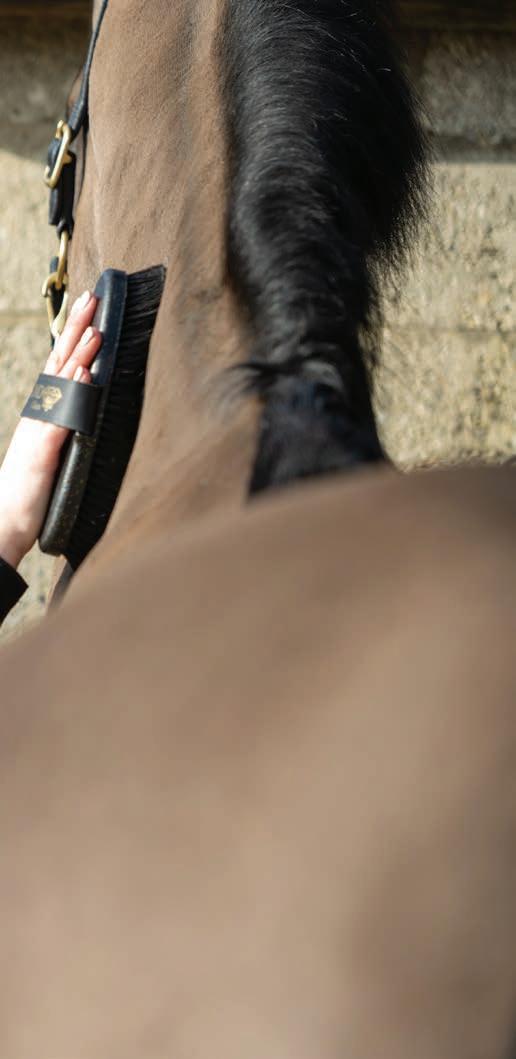










Learn how to use gratitude to your advantage by listing on a daily basis five things you’re grateful for

Successful jumping is all about getting the right canter rhythm – once you have that, everything else should fall neatly into place. In my new series, I’m going to talk you through three exercises that will help you find your flow. So, not only will you have a higher chance of jumping clear, but your rounds will also be more comfortable to ride and look effortless.
Up first is a clockface exercise. We’re going to start off by working on your horse’s natural rhythm and then add some adjustability within the pace.

Set it up
You only need four poles and space to create a 20m circle for this exercise. Place one pole on each quarter of your circle – walk the line between each one, making sure the distances are equal so your horse can comfortably fit in four strides in each quarter.
Envisage the perfect circle running through the middle point of each pole and stay disciplined in your riding to achieve that line
The aim is to ride through this exercise in canter, but start off in walk and then have a go in trot to introduce your horse to the poles, as they come up quickly. As you ride around, keep a natural rhythm and simply focus on riding the line.
Depending on your horse’s stamina and strength, ride through a few circles at a time, go large to give him a chance to rest and process, then repeat the exercise on the other rein.

Despite being a relatively straightforward exercise, this has so many benefits beyond improving rhythm and practising adjustability. It will also help establish… suppleness strength balance



It’s all too easy – and very common – to throw away marks in a dressage test by neglecting some of the finer detail. While your 20m circles might be spot on and your horse may have three balanced paces, there are several other elements to riding a test that will help you gain extra marks.
In this feature I’ll highlight some of the movements we often forget to practise. Put in the hard work now and you’ll find your overall percentages start to rise.
Your first and last impression to the judge is so important, yet centre lines are often neglected in training.
What’s the judge looking for?
Your centre line must be on the centre line, not a metre either side of it, and you’ll need to ride straight from A–C showing purposeful steps. Put it into practice
• As you approach the end of the long side, think of
riding a half 10-metre circle from the corner marker to the centre line.
• Looking where you want to go in advance will help you to ride it more accurately.
• Then, once you’re on the centre line, ride forward. If you don’t have enough energy you’re more likely to ride a wobbly line.
• Remember to practise your centre lines from both directions so that you work on your horse’s straightness, too.

Teach your horse to do canter centre lines because once he can do this, trotting a centre line will be a piece of cake.

With the right approach, you can lift the gloom and view winter as an opportunity rather than a limitation

With each season, there are positives and negatives, especially when you’re an equestrian who’s outside come rain or shine. And while we can’t control the weather, we can adapt to whatever it throws at us. That way, we can always make the most of it, whether that’s glorious, sunny days or continuous rain for what seems like weeks on end. Winter is perhaps the hardest time because, coupled with the dispiriting wet and cold, there are also the longer hours of darkness to contend with. But with the right approach, you can lift the gloom and, instead, view winter as an opportunity rather than a limitation.
Prepare your horse’s stable by doing any maintenance needed so you’re ready when bad weather arrives. If you have a field shelter, check it for damage and give it a deep clean.
Leaving smaller tasks for later only turns them into larger ones. By being aware and mindful each day, you’ll keep the positive flow moving forward.

There are plenty of jobs to be done in winter, so break them down into daily, weekly and monthly tasks. Decision fatigue can be exhausting, but by having a plan, those decisions are already made, so your life will become easier in all respects. In turn, this will offer consistency for your horse, too.
Plan your horse’s routine around your other commitments, the time available and what you want to do with your horse over the winter, whether that’s turning him away or continuing to ride him throughout. Estimate how long each task will take – you’ll be surprised at what you can achieve in 10 minutes when you’re focused on the task in hand.


Part one: understanding symmetry
Symmetry plays a significant role in both your and your horse’s posture and performance, as Ali Williamson explains

Ali Williamson is a qualified and experienced Pilates and Equipilates Biomechanics trainer with a particular interest in rider posture.

Arider with perfect posture trotting down the centre line makes an elegant, graceful picture. But good posture isn’t only about aesthetics – it’s essential for functionality as well.
Your posture is defined by many factors, including genetics, body type, right or left dominance, activities and hobbies, previous and current injuries and your lifestyle. Some of these influencing factors, such as genetics, can’t be changed, but others – particularly your lifestyle habits – can.
Making positive changes can affect and improve how we present ourselves, carry out our daily lives and ride our horses. So, let’s learn more about why symmetry is important in riding and how you can improve your posture.
The human body has evolved to be relatively symmetrical, but there are many things in life that can lead us to become asymmetrical and therefore have bad posture, and this can result in discomfort, dysfunction and injury.
It’s well known that an asymmetrical rider, among other things, can cause asymmetry in the horse. As riders, we make up 50% of the partnership with our horse, so it’s important to understand that if your horse feels unbalanced or perhaps heavier on one rein, for example, it could be your asymmetry that’s causing it.
While it’s essential to ensure any asymmetries are addressed in your horse, it’s equally important to look at the impact you might be having on him, rather than simply relying on your preferred bodyworker to correct him, or your saddle fitter to ensure his tack fits. If you’re unstable, unbalanced or unequally loading him, it will make symmetrical movement much more difficult and uncomfortable.
Imagine carrying a heavy rucksack that has much more weight in one side than the other. It would quickly become uncomfortable and annoying, so you’d be likely to shift it around to make yourself more comfortable, and this is the same for our horses when they adapt their bodies to accommodate ours.
DID YOU KNOW?
Looking to add extra sparkle to your horse’s coat? Just 25ml of linseed oil per day can make a big difference.

Ensure your horse’s coat stays healthy through the winter months with our help
Winter can be a challenging time to keep your horse’s coat looking and feeling great. In particular, mud, a lack of sunlight (vitamin D), longer hair growth and dietary changes are all factors that can leave the coat looking dull. So what can you do? We’ve come up with some shining solutions.

A healthy coat starts within, which is why providing your horse with a balanced diet is crucial, and this means adding vitamins and minerals that are lacking from grazing and forage.
If your horse has a bucket feed, the easiest way to do this is to ensure he’s on a suitable complete feed for his needs, fed at the recommended rate for his size and workload. If your horse doesn’t need additional energy to maintain weight or fuel his workload, a feed balancer is a cost-effective, easy way to provide the vitamins he needs. Most are pelleted, so can be fed by hand, in a treat ball or with a forage-based bucket feed.

Regular grooming plays a big part in creating a healthy coat because brushing stimulates blood flow, which delivers nutrients to the hair follicles and encourages new hair growth. Keep your grooming kit well stocked – that way you’ll have a brush for every area of your horse’s body, whether it’s a dandy brush to remove dried mud from legs, a body brush for clipped areas or a comb to keep manes and tails tangle-free. Grooming is a great upper body workout for you, too – so what’s not to like?
Gently use a rubber curry comb in a circular motion over large muscles – not only will this provide your horse with an enjoyable massage, but you’ll be promoting better circulation (and therefore skin health) at the same time.

